ESP TOYOTA TUNDRA 2020 Owners Manual (in English)
[x] Cancel search | Manufacturer: TOYOTA, Model Year: 2020, Model line: TUNDRA, Model: TOYOTA TUNDRA 2020Pages: 52, PDF Size: 3.85 MB
Page 27 of 52
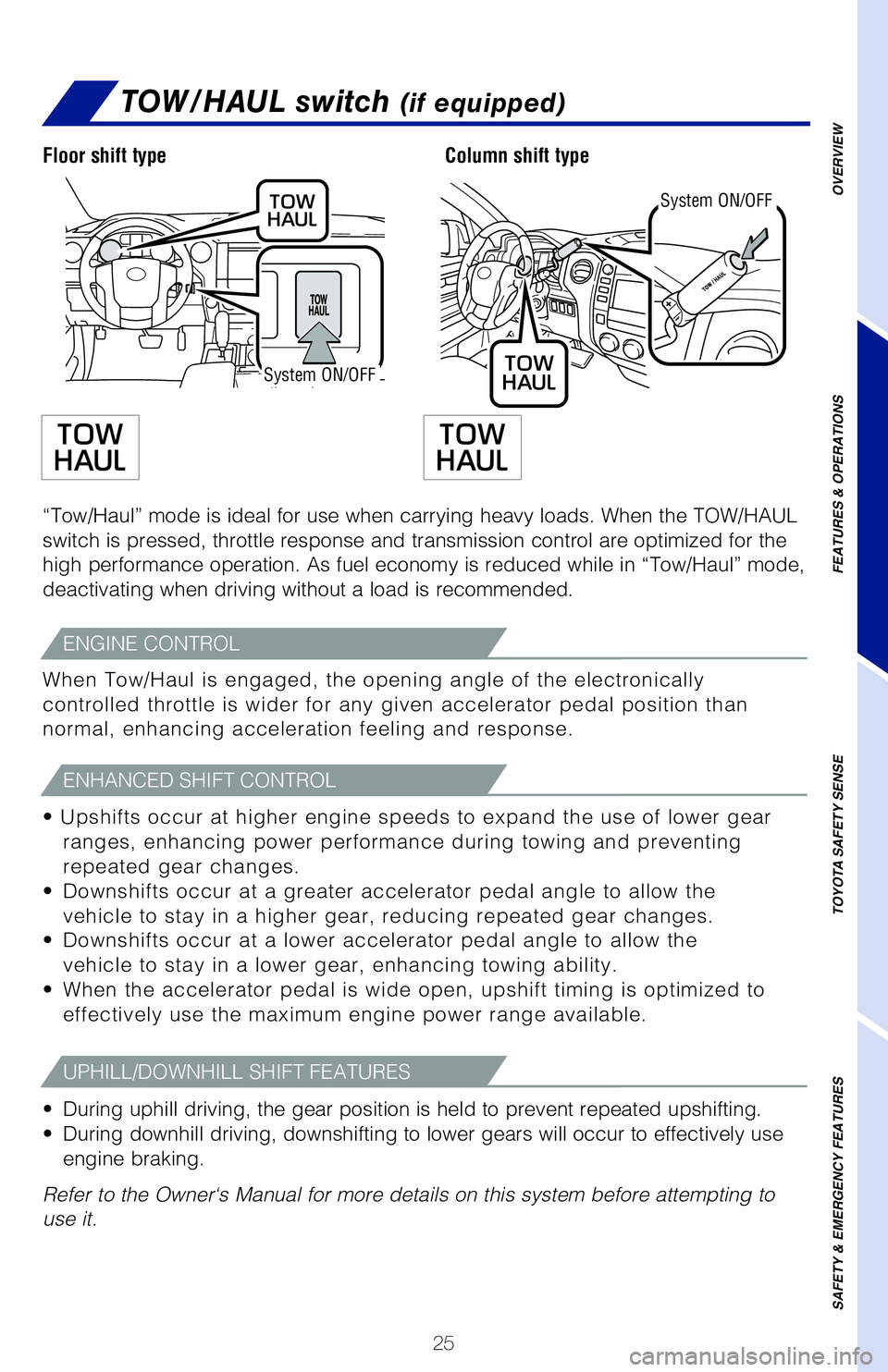
25
TOW/HAUL switch (if equipped)
“Tow/Haul” mode is ideal for use when carrying heavy loads. When the TOW/HAUL
switch is pressed, throttle response and transmission control are optimized for the
high performance operation. As fuel economy is reduced while in “Tow/Haul” mode,
deactivating when driving without a load is recommended.
• Upshifts occur at higher engine speeds to expand the use of lower gear
ranges, enhancing power performance during towing and preventing
repeated gear changes.
• Downshifts occur at a greater accelerator pedal angle to allow the
vehicle to stay in a higher gear, reducing repeated gear changes.
• Downshifts occur at a lower accelerator pedal angle to allow the
vehicle to stay in a lower gear, enhancing towing ability.
• When the accelerator pedal is wide open, upshift timing is optimized to
effectively use the maximum engine power range available.
When Tow/Haul is engaged, the opening angle of the electronically
controlled throttle is wider for any given accelerator pedal position than
normal, enhancing acceleration feeling and response.
• During uphill driving, the gear position is held to prevent repeated upshifting.
• During downhill driving, downshifting to lower gears will occur to effectively use
engine braking.
Refer to the Owner‘s Manual for more details on this system before attempting to
use it.
Floor shift type
System ON/OFF
System ON/OFF
Column shift type
ENGINE CONTROL
ENHANCED SHIFT CONTROL
UPHILL/DOWNHILL SHIFT FEATURES
OVERVIEW
FEATURES & OPERATIONS
TOYOTA SAFETY SENSE
SAFETY & EMERGENCY FEATURES
Page 29 of 52
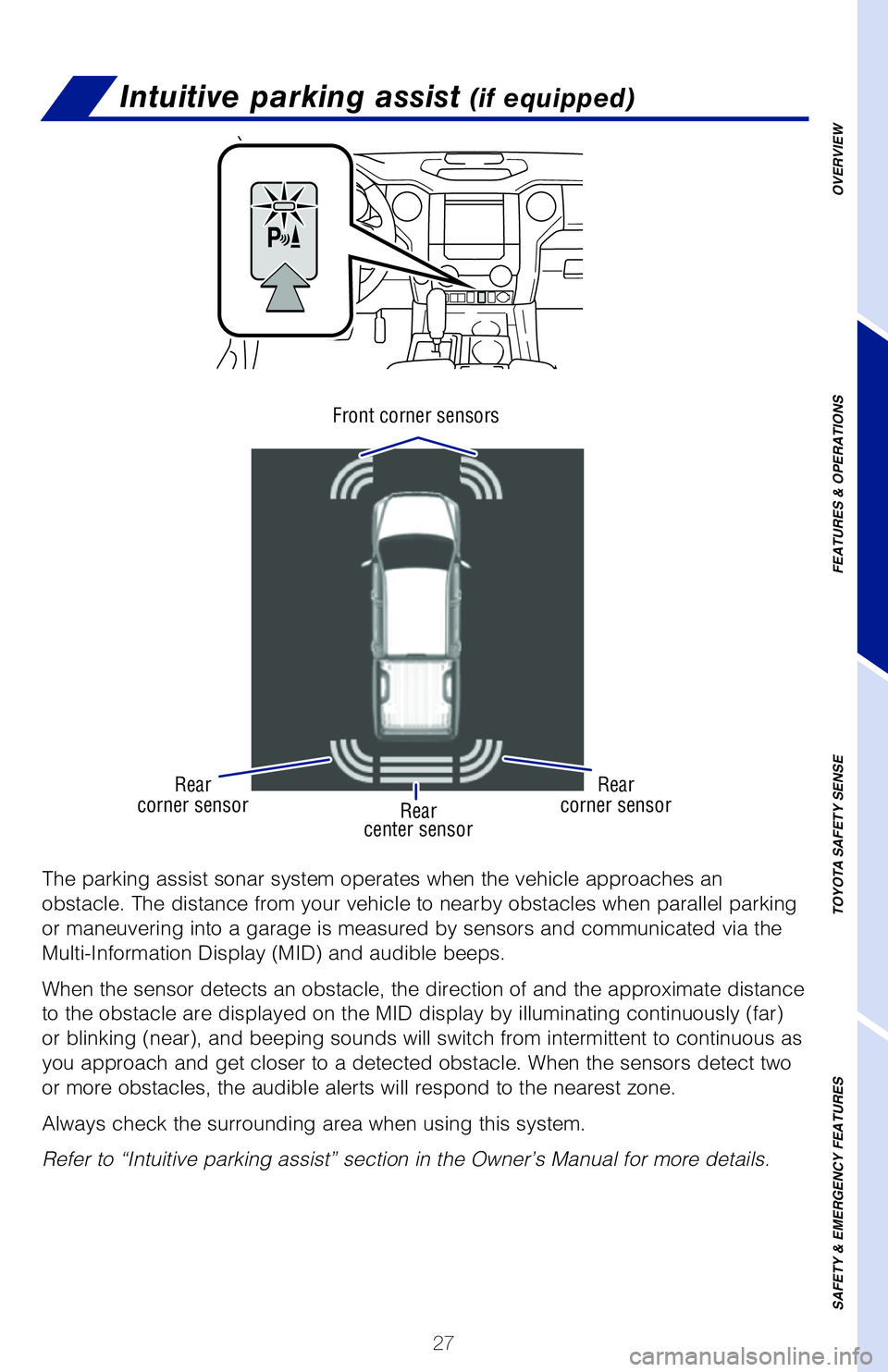
27
Intuitive parking assist (if equipped)
The parking assist sonar system operates when the vehicle approaches an
obstacle. The distance from your vehicle to nearby obstacles when parallel parking
or maneuvering into a garage is measured by sensors and communicated via the
Multi-Information Display (MID) and audible beeps.
When the sensor detects an obstacle, the direction of and the approximate distance
to the obstacle are displayed on the MID display by illuminating continuously (far)
or blinking (near), and beeping sounds will switch from intermittent to continuous as
you approach and get closer to a detected obstacle. When the sensors detect two
or more obstacles, the audible alerts will respond to the nearest zone.
Always check the surrounding area when using this system.
Refer to “Intuitive parking assist” section in the Owner’s Manual for more details.
Rearcenter sensor
Front corner sensors
Rear corner sensorRear corner sensor
OVERVIEW
FEATURES & OPERATIONS
TOYOTA SAFETY SENSE
SAFETY & EMERGENCY FEATURES
Page 40 of 52
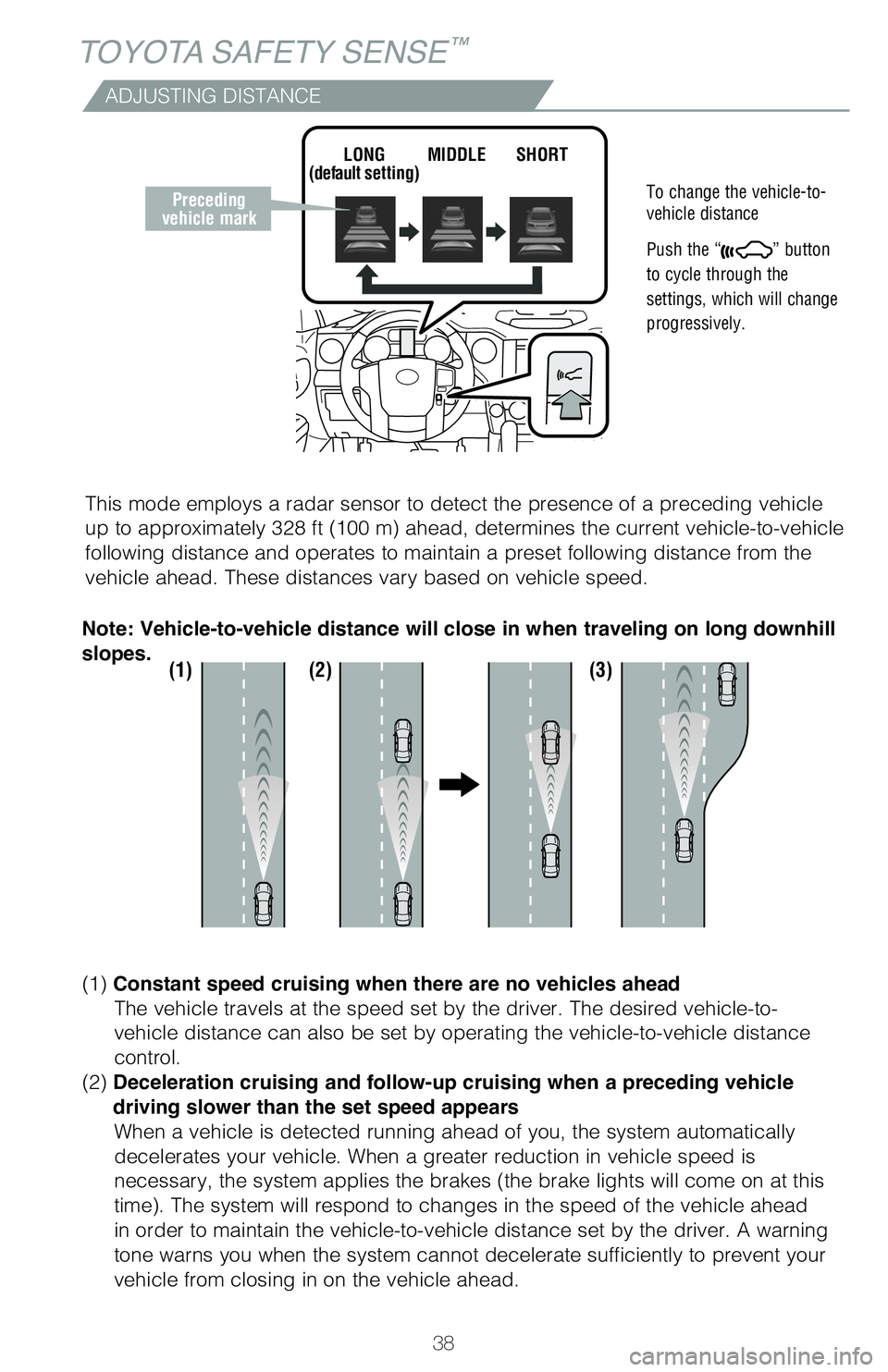
38
TOYOTA SAFETY SENSE™
ADJUSTING DISTANCE
To change the vehicle-to- vehicle distance
Push the “” button
to cycle through the
settings, which will change
progressively.
This mode employs a radar sensor to detect the presence of a preceding vehicle
up to approximately 328 ft (100 m) ahead, determines the current vehicle-to-vehicle
following distance and operates to maintain a preset following distance from the
vehicle ahead. These distances vary based on vehicle speed.
(1) (2) (3)
(1) Constant speed cruising when there are no vehicles ahead
The vehicle travels at the speed set by the driver. The desired vehicle-to-
vehicle distance can also be set by operating the vehicle-to-vehicle distance
control.
(2) Deceleration cruising and follow-up cruising when a preceding vehicle
driving slower than the set speed appears
When a vehicle is detected running ahead of you, the system automatically
decelerates your vehicle. When a greater reduction in vehicle speed is
necessary, the system applies the brakes (the brake lights will come on at this
time). The system will respond to changes in the speed of the vehicle ahead
in order to maintain the vehicle-to-vehicle distance set by the driver. A warning
tone warns you when the system cannot decelerate sufficiently to prevent your
vehicle from closing in on the vehicle ahead.
Note: Vehicle-to-vehicle distance will close in when traveling on long downhill
slopes.
Preceding vehicle mark
LONG(default setting)MIDDLE SHORT
Page 44 of 52
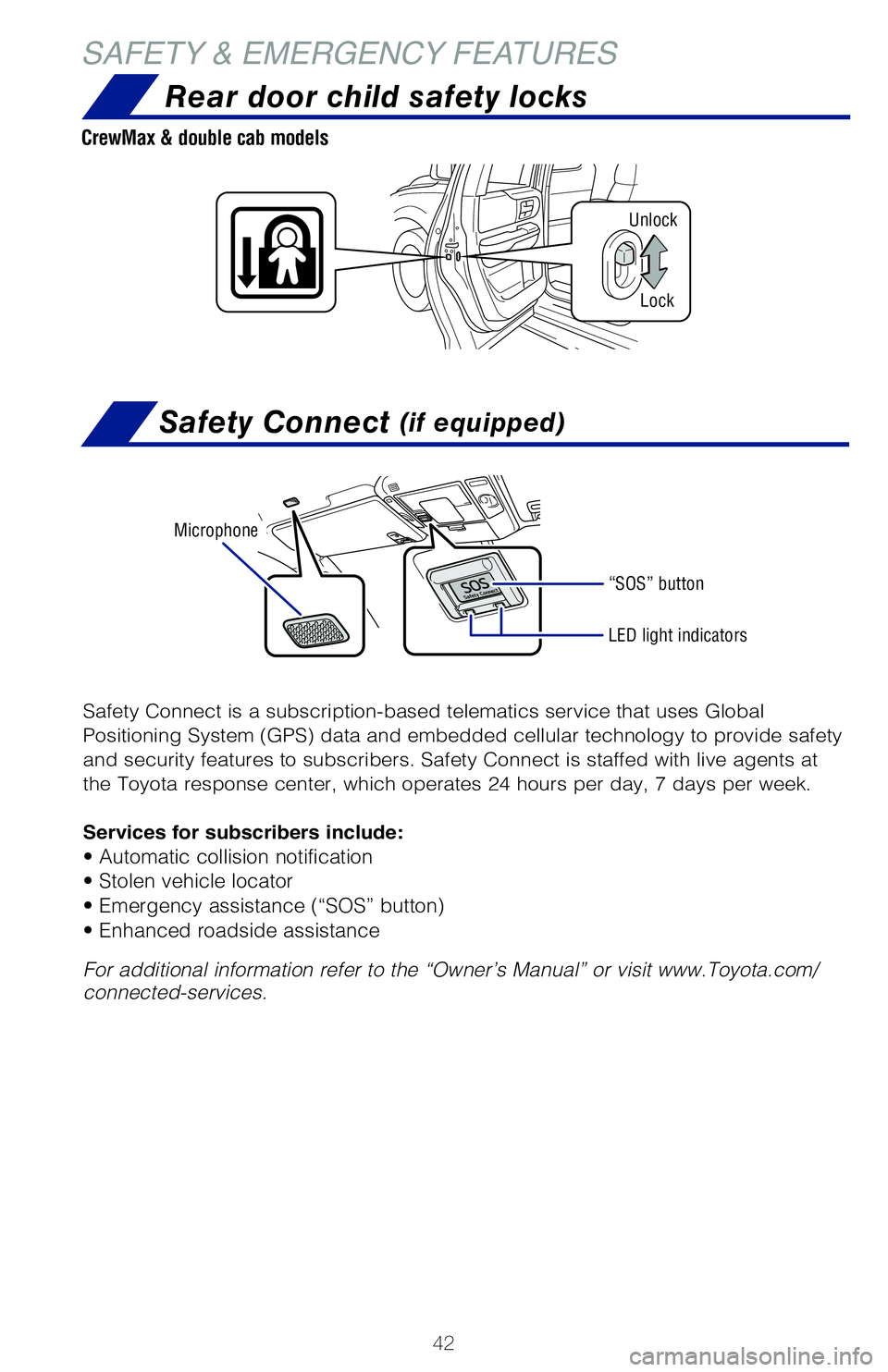
42
Rear door child safety locks
CrewMax & double cab models
SAFETY & EMERGENCY FEATURES
Safety Connect (if equipped)
Safety Connect is a subscription-based telematics service that uses Global
Positioning System (GPS) data and embedded cellular technology to provide safety
and security features to subscribers. Safety Connect is staffed with live agents at
the Toyota response center, which operates 24 hours per day, 7 days per week.
Services for subscribers include:
• Automatic collision notification
• Stolen vehicle locator
• Emergency assistance (“SOS” button)
• Enhanced roadside assistance
Microphone
LED light indicators
“SOS” button
For additional information refer to the “Owner’s Manual” or visit www.Toyota.com/ connected-services.
Unlock
Lock
Page 46 of 52
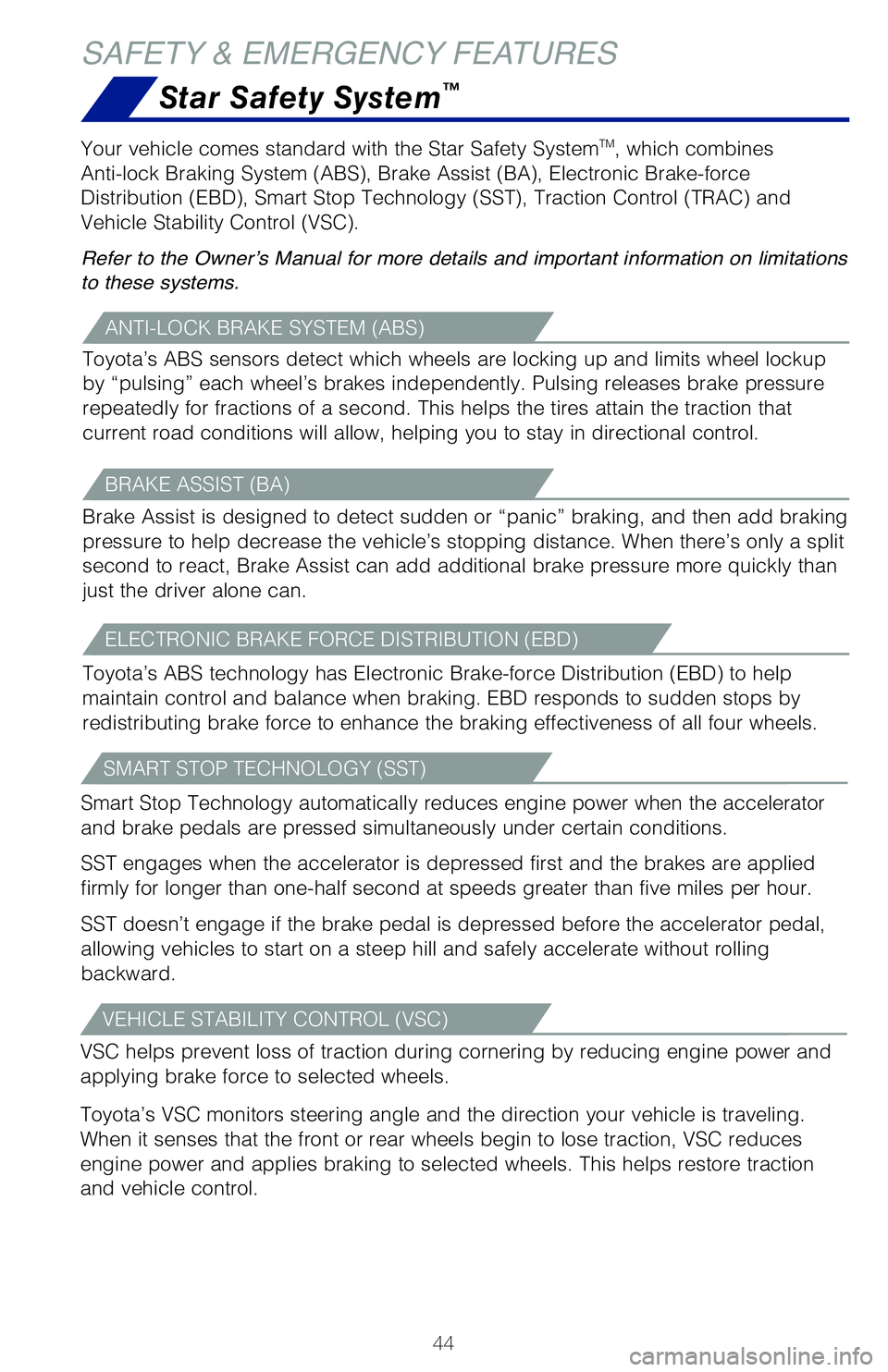
44
SAFETY & EMERGENCY FEATURES
Star Safety System™
ANTI-LOCK BRAKE SYSTEM (ABS)
Toyota’s ABS sensors detect which wheels are locking up and limits wheel lockup
by “pulsing” each wheel’s brakes independently. Pulsing releases brake pressure
repeatedly for fractions of a second. This helps the tires attain the traction that
current road conditions will allow, helping you to stay in directional control.
BRAKE ASSIST (BA)
Brake Assist is designed to detect sudden or “panic” braking, and then add braking
pressure to help decrease the vehicle’s stopping distance. When there’s only a split
second to react, Brake Assist can add additional brake pressure more quickly than
just the driver alone can.
ELECTRONIC BRAKE FORCE DISTRIBUTION (EBD)
Toyota’s ABS technology has Electronic Brake-force Distribution (EBD) to help
maintain control and balance when braking. EBD responds to sudden stops by
redistributing brake force to enhance the braking effectiveness of all four wheels.
Your vehicle comes standard with the Star Safety SystemTM, which combines
Anti-lock Braking System (ABS), Brake Assist (BA), Electronic Brake-force
Distribution (EBD), Smart Stop Technology (SST), Traction Control (TRAC) and
Vehicle Stability Control (VSC).
Refer to the Owner’s Manual for more details and important information on limitations
to these systems.
SMART STOP TECHNOLOGY (SST)
Smart Stop Technology automatically reduces engine power when the accelerator
and brake pedals are pressed simultaneously under certain conditions.
SST engages when the accelerator is depressed first and the brakes are applied
firmly for longer than one-half second at speeds greater than five miles per hour.
SST doesn’t engage if the brake pedal is depressed before the accelerator pedal,
allowing vehicles to start on a steep hill and safely accelerate without rolling
backward.
VEHICLE STABILITY CONTROL (VSC)
VSC helps prevent loss of traction during cornering by reducing engine power and
applying brake force to selected wheels.
Toyota’s VSC monitors steering angle and the direction your vehicle is traveling.
When it senses that the front or rear wheels begin to lose traction, VSC reduces
engine power and applies braking to selected wheels. This helps restore traction
and vehicle control.